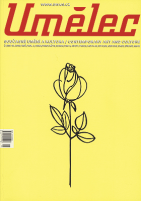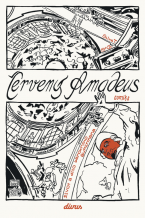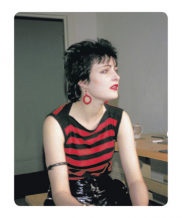| Umělec magazine 2000/4 >> Fighting Against Blindness (An intervew with Lóránd Hegyi) | List of all editions. | ||||||||||||
|
|||||||||||||
Fighting Against Blindness (An intervew with Lóránd Hegyi)Umělec magazine 2000/401.04.2000 Lenka Lindaurová a Karel Císař | q & a | en cs |
|||||||||||||
|
"We met with Lóránd Hegyi, director of the Vienna-based Ludwig Museum, at the Modern and Contemporary Art Collection of the National Gallery in Prague to talk about the rerun of his last year’s exhibition La casa, il corpo, il cuore, his current exhibition Zeitwenden in Vienna, art after the death of the grand narrative, and about the influence of the disintegration of the Habsburg monarchy on contemporary art in central and eastern Europe.
How would you compare the exhibition La casa, il corpo, il cuore here at Veletržní palác, which is strongly based on identity, with the exhibition Zeitwenden in Vienna, which seeks a position in the arts in the future? The two exhibitions are basically very different. La casa, il corpo, il cuore focuses on a very precise and theoretically based position of contemporary art which is formulated on the basis of Lyotard, Arthur Danto and Paul Wood—art after the death of the grand narrative. This means what contemporary artists can do in a vacuum. Is this vacuum after the death of the grand narrative—after the end of census comunis—a negative phenomenon, emptiness, a hole, or is it a positive situation, a challenge, a new kind of liberty? It focuses on how artists are using the old metaphors with completely new meanings, the house, the body, the heart, the idea to create a home, security, the connotation of the body and emotion. It’s a very old, very principal subject of the arts, how artists are working with these old metaphors today in a very special context where there are no general values. There is no longer a census comunis—closed and coherent linguistic structures, values, systems—where we believe either in the mythological legitimization of art, or in the scientific legitimization of art, or in the utopian legitimization of art, like the avant-garde did. Arthur Danto pointed out that old reality is anthropological experience. Zeitwenden is a completely different, open strategy. It’s a huge question but without an answer. The question is: What does the future mean for the artist, what does the turn of the century and the turn of the millenium mean for the artist? Is millenium euphoria a real subject for the arts or not? Do we stand at the beginning of a new age or is it only a utopian or marketing idea of the society? The Vienna exhibition was the result of the work of 33 curators from all over the world— Japan, Brazil, Africa, North and Latin America, west and eastern Europe. In 1997, we met in Bonn where everybody made three propositions. So in the end 99 artists were proposed. Everybody had a slightly different idea of what contemporary art means. It was more of a statistical question: by chance and by consideration, the 33 curators represented, statistically, a certain slice of worldwide opinion. Everybody had their preferences, their own strategy. I proposed one Austrian artist, one Brazilian artist and one Yugoslav artist, but I didn’t think about nationality. In the letter of invitation to the curators, it was made very clear that no nationality, no political correctness, no continental selection applied. We didn’t count how many men, how many women, how many western artists, how many eastern artists, how many peripheral artists. It was not a coherent subject: The exhibition presented the heterogeneity of contemporary art. Not only “hetero” at the level of artistic production but also on the level of curatorial practice. The common ground is that both exhibitions try to give mountains of information on the contemporary situation. In Zeitwenden, my special thematic and strategic consideration is within its own concept because a lot of curators and I share this idea—art after the death of the grand narrative—but it doesn’t have the ambition to create any coherent thematic exhibition. One of your intentions in Zeitwenden was to encourage artists to make site-specific works for the exhibition. How did you succeed? We don’t push artists; we ask artists to create works or to choose a work for this exhibition they think is adequate to the subject. There are artists who always work on site and who always produce new work, like Bruna Esposito, Fernarda Gomes. There are artists who never work like this, like On Kawara, Roman Opalka. When we decided to invite Roman Opalka, On Kawara or Georg Baselitz and at the same time Martin Walde, Fernanda Gomes and Bruna Esposito, we had to accept that there would be different artistic strategies. We wanted to show that there are artists who are working outside any frame. They are great, sovereign personalities who are working with the idea of how the times are changing. When we invited very typical contemporary positions like Txomin Badiola, Esposito, we definitely knew they would do works especially for this exhibition. In Zeitwenden, artists from the periphery of contemporary art and those working with classical media were mostly situated in Künstlerhaus whereas the stars of contemporary art were placed in the Museum of the 20th Century. Is this imbalance a mistake? I don’t think that statistically more artists from the so-called periphery are in the Künstlerhaus than the other building. Actually, in Vienna, the Künstlerhaus is much more important than the Museum of the 20th century, which is a very peripheral location. If somebody is in the Künstlerhaus, for a Viennese audience, it is much more prestigious. We made a thematic presentation. In the Museum of the 20th century, which is smaller than the Künstlerhaus, it was easier to make thematic groups. Upstairs we have a section for spirituality and sensuality. Sensual experiences are transformed into spiritual values: Marina Abramović, Bruna Esposito, Fernanda Gomes, Nedko Solakov and two or three other artists. Downstairs we have two subjects: the megalopolis and time. There you find Gloria Friedmann, Roman Opalka, On Kawara. In the Museum of the 20th century, because of the empty white box architecture, we could create our own architecture as we saw fit, and it was easy to make the three thematic groups. Because we couldn’t move the walls in the Künstlerhaus, we concentrated more on the subjects of history, personal history and the imagination. The Künstlerhaus has double the number of artists because the space is larger. If you consider Franz West, the number one Austrian artist, or Baselitz who is one of the most important German artists today, they are in the Künstlerhaus. So I wouldn’t say it’s marginal. Do you think that there is a common theme for artists from central and eastern Europe? I have worked for ten years in Vienna for a real and serious integration of central and eastern European artists. I have never had any national exhibitions. I never did contemporary art from Hungary, from Poland, from the Czech Republic… I have two parallel strategies. At the museum level, I invite the same number of artists from central and eastern Europe to different thematic exhibitions as I do from any other region and they’re always present. The question is whether this is good or not. In the long term, I think it is the only possible strategy. These countries are always outside, and the typical way they are dealt with is perhaps not attractive enough for them because that normally means they are not more present than any other region: They are almost unknown and the normal presentation is not enough. On the other hand, in the long term this is the only way because if things are pushed, if things are forced, if they are somehow artificial, we lose credibility. I think it was a big mistake, including my activities earlier, that we tried to push too quickly and too superficially without giving background information. We believed that our artists were as important as artists from the West, artists from the art centers, without giving the information as to why they are important. I am fighting against the blindness of a lot of western curators. On the other hand, I understand this because if they don’t know this art generally, they can’t develop a certain kind of visual sensibility so that they could understand the values. If I don’t learn a language, I can’t understand it. I can’t understand the poetical richness of a language I don’t know. Which means that if Harald Szeemann made one visit to Prague for one day, and one day to Warsaw, he couldn’t possibly understand the deepness of, for example, Jiří Kovanda. We must give credibility to these people. I, as an art historian, can work from a long term perspective. My long term strategy is that we have to reconstruct the whole of European history. We are not interesting enough. It’s bitter to say, but that’s my experience as a Hungarian art historian working in Vienna for ten years. We are not enough of a curiosity; we’ve not gone far enough; we are not interesting enough for an excursion, for a discovery, because we are simply behind. We are small poor neighboring countries. It is very exciting and interesting to go to China, to Africa, to Brazil to find artists. It’s not attractive enough to go to Brno, to Bratislava, to Prague... That is reality. Whether we like it or not is another thing. We can’t force people to do something they don’t think is interesting. But with a lot of work we can say: Think a little bit, dear friends in Basel, Paris, Berlin and London, think about what it means to be East and West, when the so-called eastern European provincialism began. It was not 1945; it is not true that the Iron Curtain divided us there. I’m thinking of the European cultural map of the entire 20th century. It was just after World War I when the three big dynasties collapsed—the Russian, the German and the Habsburg dynasties. In Germany, because of the October Revolution, the Weimar Republic, it was at least an experiment to establish a modern state. In the Soviet Union, the Bolshevik revolution, for at least 10, 15 years, declared an experiment which was very important for the whole world because it was THE big illusion of the 20th century. Everybody, whether you loved it or hated it, looked to Moscow as a model and western intellectuals traveled there in the mid-1930s. Le Corbusier built in Moscow because it was somehow interesting. Nobody came to these poor central European countries after the collapse of the monarchies. Perhaps, the only exception in a certain way was Czechoslovakia because it was the only democratic modern state which really wanted modernization. But even Czechoslovakia was too concentrated on national identity, but fortunately for Czechoslovakia this national identity was connected to modernization. Hungary, Romania, Poland, Yugoslavia, Bulgaria and even Austria were looking for their national identities in the past, so they went back to the 19th century for the big illusions, romanticism, or they went back further to the middle ages. The other big mistake was that all these small countries tried to create separate identities from their neighbors. It was almost a perverse self-limitation. It was not identity-based modernization towards Europe and towards modernity. Provincialism began in the 1920s. If we can give a lot of information with a lot of work to show that Europe is and has alawys been a heterogeneous area where perhaps at a certain time Prague or Budapest was as important as Lisbon or Barcelona, we must make it known that this categorization of “Europe,” which, unfortunately, today means the European Union, has nothing to do culturally with European values—it is very relative and very limited. Do you feel the political situation in Austria, with Jörg Haider, directly influenced your work? Are you generally interested in political topics in art? I think that the participation of the Freedom Party doesn’t directly influence everyday work in the cultural field. It has a very bad effect on the general ambience of the country—the general spirit. If we’re talking about influence on the artistic life, it is much more of an emotional lethargy than a direct intervention in the program. What has been, for a long time, a real question is how the presence of the party—which is, of course, a very aggressive party—creates a negative feeling towards contemporary art, European values, towards foreigners. As in all western societies, art and artistic circles are very far from politics. Even if the artists are doing so-called “political art,” they are in a very special protected area. If a young contemporary artist makes a work that touches on politics, the viewers who come to a gallery are not members of Haider’s party. It’s like we do the program for ourselves, and we never meet the people who vote for Haider. They never come to a museum of modern art; they have no idea what the artists do; they generally hate contemporary art or anything that is contemporary. I wrote an article for the Liberation in which I criticized the so-called democratic parties and democratic intellectuals who never made a precise, objective analysis of the phenomenon: why this party became so strong, why this party won 28% in 1999. The so-called democratic parties, the Social Democrats and the Christian Democrats, were in power for 35 years. They created the incredibly strong politics of the privileged; they absolutely controlled the power with anti-democratic methods. It’s very hypocritical today to say: “This ultra-radical party came to power.” How did this ultra-radical party with perhaps 10% voter support come to have 28%? Because they could canalize politically disoriented, unsatisfied people. This is the responsibility of the so-called democratic parties. Why weren’t they able to canalize and collect the unsatisfied people, young voters? 60% percent of Haider’s voters are under 30 years old. The Social and Christian Democrats gave the role of modernizer and reformer to Haider. Haider is a very cynical person without any scruples. He can play the national hero, drinking beer in the morning and in the afternoon, walk in wearing a nice, elegant suit, speak in the chamber of commerce about economic liberty, reduce taxes, and in the evening he goes to a rock concert in a T-shirt. I think in the long-term he is not a credible threat because people are not so stupid. The protest voters vote only once, not two or three times. The real problem is that the established democratic central parties were not able to develop a reform policy, they were not able to reduce bureaucracy, they could not make economic reform, reform of trade unions, reform of the pension system. They always postponed things. The tragic and unacceptable ideology of his party, the Hitler/Nazi sympathies, the anti-foreigner feelings, the xenophobia, the anti-European feelings will make a big break in Austrian society, and we will see how the majority reacts. Emotio-nally, they are in a very bad situation, but objectively I can’t imagine that a modern industrialized country in central Europe could leave the European Union. "
01.04.2000
Recommended articles
|
|||||||||||||
|
04.02.2020 10:17
Letošní 50. ročník Art Basel přilákal celkem 93 000 návštěvníků a sběratelů z 80 zemí světa. 290 prémiových galerií představilo umělecká díla od počátku 20. století až po současnost. Hlavní sektor přehlídky, tradičně v prvním patře výstavního prostoru, představil 232 předních galerií z celého světa nabízející umění nejvyšší kvality. Veletrh ukázal vzestupný trend prodeje prostřednictvím galerií jak soukromým sbírkám, tak i institucím. Kromě hlavního veletrhu stály za návštěvu i ty přidružené: Volta, Liste a Photo Basel, k tomu doprovodné programy a výstavy v místních institucích, které kvalitou daleko přesahují hranice města tj. Kunsthalle Basel, Kunstmuseum, Tinguely muzeum nebo Fondation Beyeler.
|


































 New book by I.M.Jirous in English at our online bookshop.
New book by I.M.Jirous in English at our online bookshop.
Comments
There are currently no comments.Add new comment